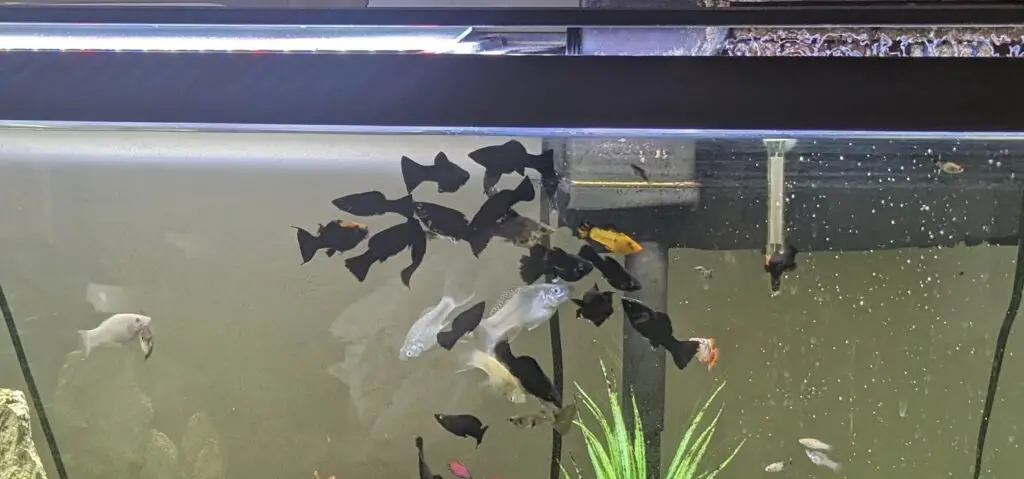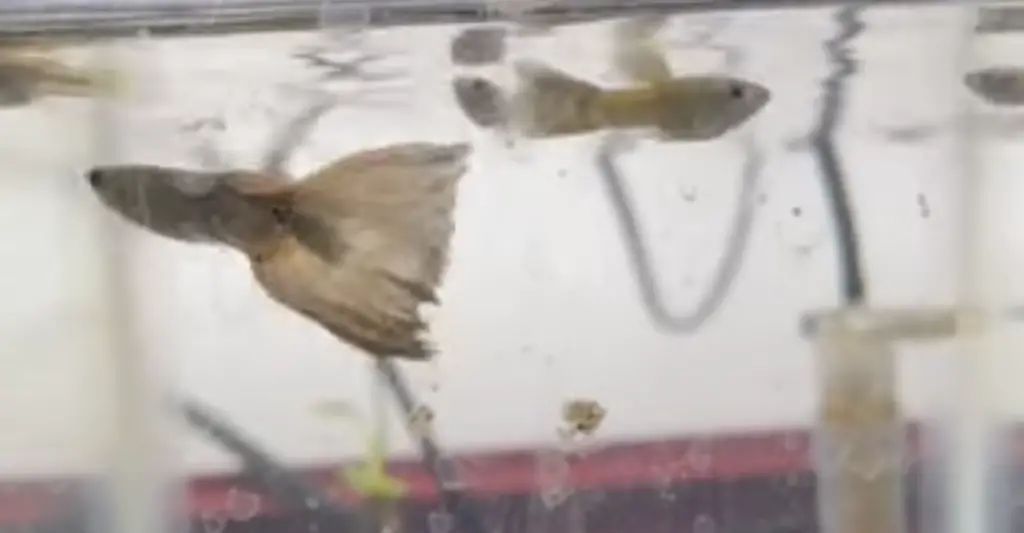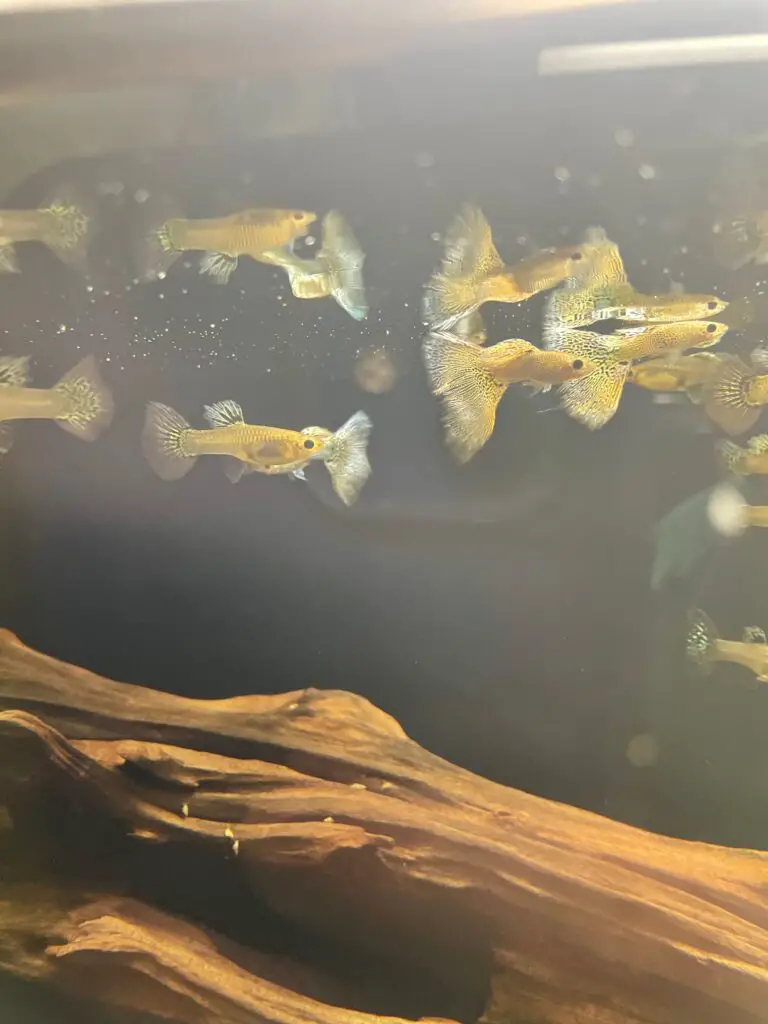Guppies and mollies are both popular choices for aquariums, and many hobbyists wonder if these two species can be kept together. The short answer is yes, guppies and mollies can generally live together in the same tank as long as certain conditions are met.
First, it’s important to make sure that the tank is large enough to accommodate both species.
Guppies and mollies are both smaller community fish, but they still need plenty of space to swim. A tank that is at least 20 gallons in size is recommended for a small group of these fish.
In addition to size, the water conditions in the tank are also very important for the well-being of guppies and mollies. Both species aren’t very particular with their water parameters. They can live in a pH level between 7.0 to 8.5 and a temperature between 72 and 82 degrees Fahrenheit.
The only thing you have to make sure of with your water is that it is clean. Do regular water changes of 25-50% weekly. Guppies and mollies are very resilient to dirty water but the cleaner your water the healthier your fish will be.

What do guppies and mollies eat?
Guppies and mollies are both omnivorous fish, which means they will eat both plant and animal matter. Making it easy since they both eat the same things so no special feedings for one or the other.
In the wild, they will feed on a variety of small aquatic organisms, including insects, worms, and crustaceans. In captivity, they can be fed a varied diet consisting of both live and prepared foods.
Live foods that can be fed to guppies and mollies include:
- Brine shrimp
- Daphnia
- Grindal worms
- Mosquito larvae
Prepared foods that can be fed to guppies and mollies include:
- Flakes or pellets specifically formulated for omnivorous fish
- Frozen or freeze-dried foods, such as bloodworms, brine shrimp, or daphnia
- Vegetables, such as blanched spinach, lettuce, or peas
It’s important to provide a varied diet and not rely solely on any one type of food.
Overfeeding can lead to health problems such as bloat, so it’s important to only provide enough food for the fish to consume in a few minutes at each feeding.
I also wouldn’t feed more than one to two times a day. This will help so you don’t overfeed.
It’s also a good idea to supplement their diet with vegetables, as this can help provide important nutrients and help prevent constipation and bloat.
Another factor to consider when keeping guppies and mollies together is their behavior. Guppies are generally peaceful and non-aggressive, while mollies can be a bit more aggressive.
To minimize conflicts, it’s a good idea to provide plenty of hiding places and spaces for the fish to claim as their own.
Why is my Molly chasing my guppy?
It is not uncommon for fish to so aggressive behavior, particularly towards smaller fish or those that appear weaker.
Molly fish are known to be omnivorous and may see small fish as a potential food source.
In some cases, fish may also chase or nip at each other as a way of establishing dominance or hierarchy within the group.
If you are concerned about the behavior of your Molly fish towards your guppy, there are a few things you can try to prevent or reduce the likelihood of such behavior occurring:
- Make sure that your Molly fish is well-fed. Well fed fish are lazy and less likely to be aggressive.
- Provide plenty of hiding places and areas of cover in the tank for your guppy to escape to if they feel threatened. This could include plants(live or fake), caves, or other structures.
- Consider separating the two fish if the chasing behavior is persistent or if you are unable to prevent it.
Do guppies and mollies get along?
If you’re thinking about adding some guppies or mollies to your home aquarium, you might be wondering if these two popular fish species can get along.
The good news is that guppies and mollies can generally coexist peacefully in the same tank as long as they are provided with sufficient space, adequate filtration, and a suitable environment.
Both guppies and mollies are generally peaceful fish that can live together in a community tank setup. However, it’s important to keep in mind that every fish has its own personality, and there may be some individual fish that don’t get along with others.
How many mollies and guppies can you put in a 20 gallon tank?
While guppies and mollies are fairly friendly community fish. They reproduce fairly quickly so having enough space for them is a must or at least somewhere you can rehome them. 20 gallons for a community tank of guppies and mollies is about the smallest I would go.
Mollies get fairly big for a community fish so I wouldn’t suggest more than 5 or 6 in a 20 gallon with a trio or two of guppies. Or if you choose 6-8 male guppies.
Will mollies eat guppy fry?
Yea mollies will definitely eat your guppy fry if they have the chance. Mollies are opportunistic feeders and will go after your guppy fry but if your guppy fry can outrun them or hide well enough once they get to a certain size then mollies will give up.
One way to help your guppy fry survive is to separate them for a few weeks in another tank entail they are big enough and strong enough that mollies aren’t a threat.
If you don’t want to spend the time hunting down all of the guppy fry and establishing a tank for them then the next best thing is to make sure there is lots of plant cover (real or fake both work) or decorations that guppy fry can hide in or under.
Also keeping your fish well fed makes them lazier when it comes to hunting guppy fry or any other types of fry.
Will guppies eat Molly fry?
Guppies given the chance will eat your Molly fry. Just like mollies guppies are opportunistic feeders and if they can catch Molly fry then they will eat them.
One benefit that Molly fry have over guppy fry is they start bigger and so they have a shorter amount of time that guppies will be able to fit them in their mouths. Once they don’t fit in a guppies mouth then they no longer have the risk of being eaten.
Just like with guppy fry if you separate mollie fry into another tank then you don’t have to worry about your guppies eating them.
Also giving plenty of hiding spaces will make it so your mollies have a higher chance of survival.
Difference between guppy and Molly fry?
For the first week or two you may have a hard time spotting any differences between Molly and guppy fry.
The Molly fry will be slightly bigger and thicker. Whereas guppies will be smaller and slimmer.
After a few weeks, mollies will start to develop color sooner and start to take on the Molly shape.
Guppies will keep their tan color and start looking like mini female guppies.
After the first month or two the guppy fry will start gaining sexual differences. The males will start to color up and develop their tails to woo the female guppies.
The females will gain a little color and start to plump out.
Mollies in their second month will gain their full color and will look like miniature mollies. No real differences besides size.
Can molly and guppies crossbreed?
Both species belong to the family Poeciliidae, which includes a wide variety of livebearers that are known for their ability to give birth to live young rather than laying eggs.
Mollies and guppies are closely related and can interbreed to produce hybrid offspring, but this isn’t a common occurrence in the wild.
In the aquarium hobby, hybridization between mollies and guppies is more common and can be intentionally or unintentionally induced by hobbyists.
Mollies and guppies can be crossbred to produce offspring with characteristics of both parent strains, which some hobbyists who are interested in creating unique or novel fish.
However, hybridization also carries a number of risks and limitations, which should be carefully considered before attempting to breed mollies and guppies together.
One of the main risks of hybrid molly guppy babies is the potential for reduced fertility or viability in the offspring.
In addition, hybridization can also result in the production of offspring with undesirable physical or behavioral traits, which may be less appealing to hobbyists.
Another potential risk of hybridization is the potential for negative impacts on the genetic diversity and stability of the parent strains.
Due to the hybridization of guppies and mollies, it is incredibly difficult to find pure guppies and mollies in captivity or in the wild.
Despite these risks, hybrid molly and guppies can be a rewarding and interesting activity for hobbyists who are knowledgeable about the potential challenges and are prepared to manage them.
If you are interested in breeding mollies and guppies, it is important to do your research and understand the potential risks and limitations of hybridization.
Depending on the combination of the parents of hybrid guppy and Molly babies depends on what they are called. Much like if tigers and lions cross.
If the babies came from a male guppy and a female Molly then their offspring are called a golly or gollies.
If the babies came from a female guppy and a male Molly then they are called a muppy or muppies.
I find it so funny how some hybrids of fish get their names.
Are muppy or golly hybrids fertile?
The fertility of guppy and molly hybrids can vary and may depend on the specific characteristics of the parent strains and the specific genetic makeup of the hybrid individuals.
In general, hybridization between closely related species can lead to the production of offspring with reduced fertility or viability, depending on the specific genetic compatibility of the parent strains but for the most part muppies and gollies are infertile.
In brief, having mollies and guppies together in an aquarium is achievable through careful planning. The tank size must be sufficient, water conditions stable, and other fish selected appropriately. By providing suitable habitat and nourishment, mollies and guppies can live harmoniously in a shared aquarium environment. Hope to see your tanks full of guppies and mollies.


